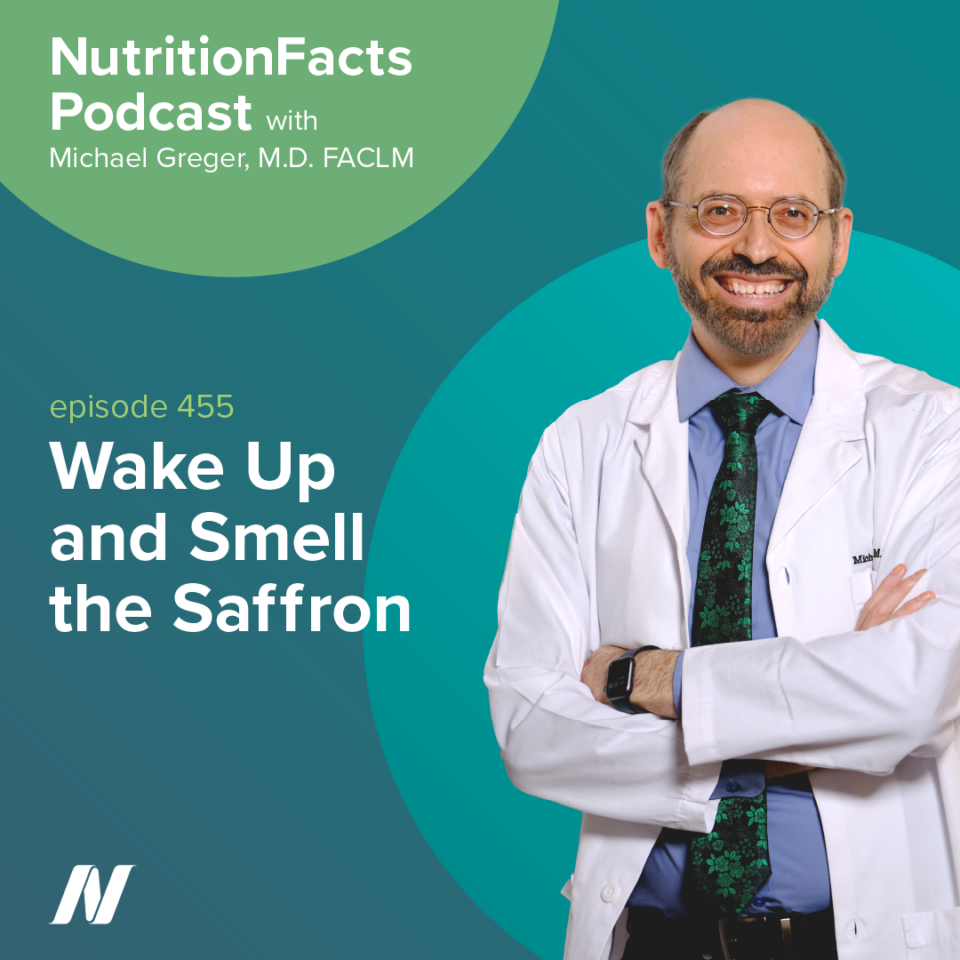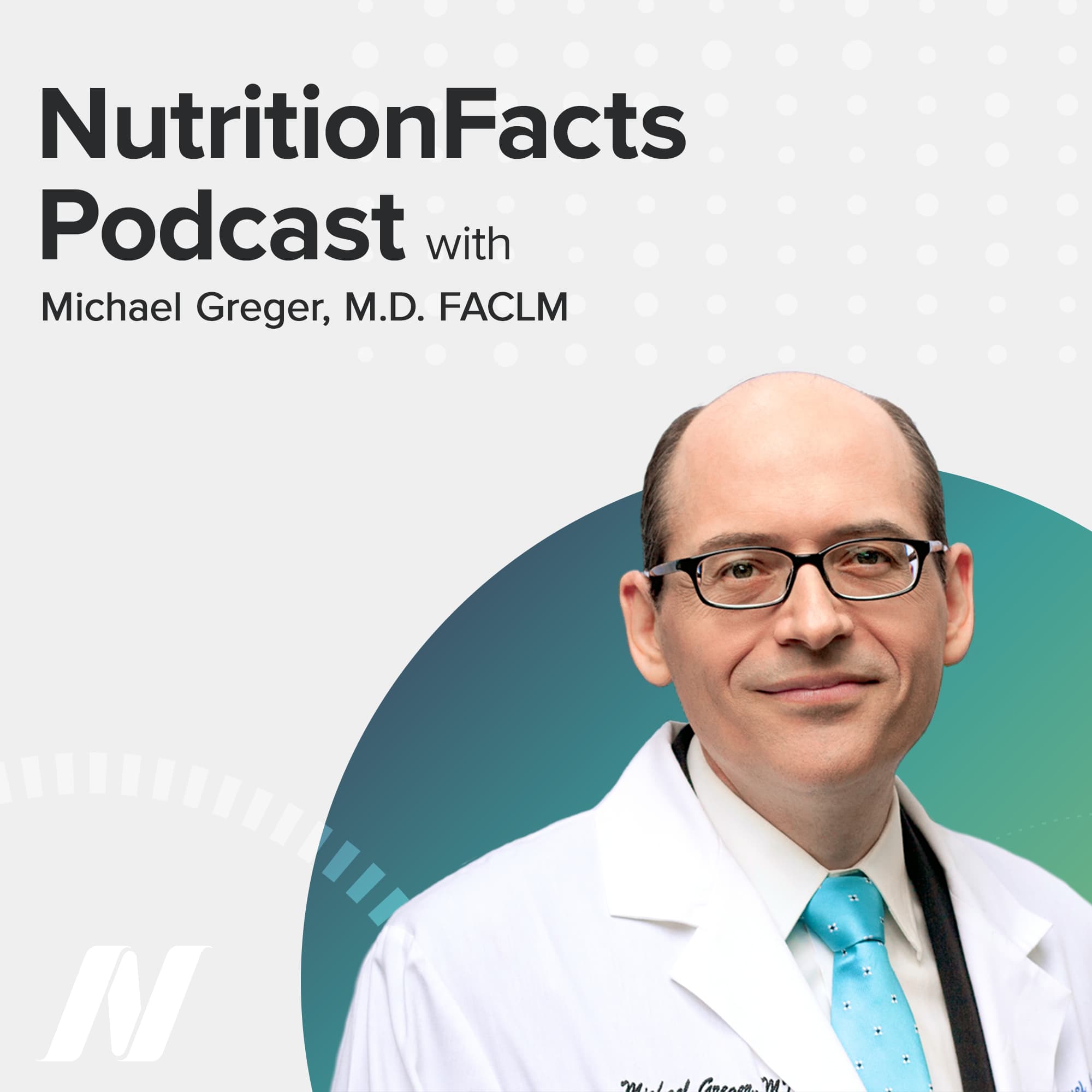In addition to two to three daily servings of green leafy vegetables, berries are considered a healthy choice for the preservation of eye health. As we age, our critical retinal pigment epithelium layer starts to break down. However, we may be able to decelerate that aging with blueberries. Human RPE cells bathed in blueberry anthocyanins had fewer free radicals and a lower proportion of aged cells, suggesting that blueberries and other red, blue, and purple pigmented fruits and vegetables may help prevent age-related macular degeneration. Protective properties have also been demonstrated in vitro on RPE cells from purple sweet potato anthocyanin, as well as the yellow pigment in turmeric and an amla extract (Indian gooseberry).
However, the only human interventional trials on berries for vision were a month-long trial of a bilberry extract that demonstrated significantly less eye strain after iPad use compared to placebo, and a study showing three weeks of blueberry juice or freeze-dried blueberry powder both significantly improved photostress recovery time (the time needed to recuperate visual acuity after bright light exposure) by about five seconds. Only one pigmented food has been put to the test in macular degeneration patients: the spice saffron.
Saffron is so potent that the whole spice can be stuffed into capsules to pit head-to-head against placebo. Those with early-stage age-related macular degeneration were randomized to a tiny pinch (20 mg, about eight threads) of saffron versus placebo for three months. Compared to the placebo group, the saffron group experienced a significant improvement in retinal flicker sensitivity—that’s our ability to pick out high-frequency light pulses (rather than seeing the flickering light as a steady beam) that diminishes with age. It’s a sensitive test of retinal function, but it is of questionable clinical value. However, there was a small improvement in visual acuity in 80 percent of the saffron subjects (being able to see one line further down on an eye chart) versus none improving in the placebo group. This is particularly important for those with age-related macular degeneration for whom vision tends to get worse over time, not better.
What about a more substantial pinch (50 mg, about 20 threads)? Compared to placebo, three months of this larger dose led to a similar improvement in visual acuity in macular degeneration patients, suggesting more is not necessarily better. Saffron is the most expensive spice there is, selling for about $200 an ounce (28 g); so, being able to get away with a 20 mg dose (about 15 cents a day) rather than a 50 mg dose (closer to 40 cents a day) could add up over the long run. Even smaller doses may work too, but just haven’t been tested.
What about the tiny pinch over a year instead of just three months? Early-stage macular patients were given 20 mg of saffron a day for an average of 14 months and average visual acuity improved by two eye chart lines. They also reported an improvement in contrast and color perception, reading ability, low-light vision, and overall quality of life. The problem is the study lacked a control group; so, it’s hard to put much stock in subjective measures of improvement. Interestingly, a six-month randomized, double-blind, placebo-controlled trial found no objective acuity improvement in either the placebo group or a 30-mg-a-day saffron group, yet reported that the patients unwittingly in the saffron group gave subjective reports of better vision and general wellbeing. The researchers suggest this may be an antidepressant effect, and indeed, a meta-analysis of a dozen randomized, double-blind, placebo-controlled trials of saffron for depression found it beat out placebo, and was found comparable to antidepressant drugs.
The largest saffron vision trial to date was a double-blind, placebo-controlled crossover trial in which 100 older adults with mild or moderate age-related macular degeneration were randomized to 20 mg of saffron a day or placebo for three months, then switched to the opposite group for an additional three months. When on the tiny daily pinch of saffron there was a significant, yet modest, improvement in visual acuity, and this was the case for both those on and off best practice therapy (the beta-carotene free AREDS supplementation), suggesting an additive benefit.
In our next story, we look at the effects of both oral and topical application of the spice saffron for male impotence.
The spice saffron has traditionally been considered an aphrodisiac. It has been shown to improve Prozac-induced sexual dysfunction in women, and men—significantly improving erectile function. If it works for drug-induced dysfunction, might it work for just regular erectile dysfunction?
Why not just use pills, like Viagra? They can work, but many men stop using them due to, for example, “adverse side-effects.” Nearly half of men decide the cons outweigh the pros. For men that don’t like drugs, there’s always surgery—the implantation of “penile prosthetic[s].” Unbelievably, “[p]enile implant usage [evidently] dates [back] to the 16th century. Early experiments involved transplanting a guy’s rib cartilage, or their actual rib, into their penis. Thankfully, space-age technologies in the 60s allowed men to keep their ribcages intact. Originally, the implants left men in a “permanently erect state,” but then the “Flexirod” was invented, with a hinge in the middle, so the guy could like bend it down in half “for improved concealment.” Of course, proper sizing is important. If the implants are too small, there can be drooping at the tip, leading to what’s called a “supersonic transport…deformity.” Why? “Because of…its resemblance to the nose of [the] Concorde” jet. Whereas “[o]verlong prostheses can also be a problem,…with the semi-rigid rods [eroding out of the penis].” Although they “generally perforate…into the urethra, [the rods] can also extrude through the [tip] or [the] shaft.” Ouch.
Now, there are inflatable devices, and perhaps one day there will be “expandable foams that respond to external magnetic fields,” or metal mesh technology “that could expand and retract in a cage-like fashion.” And, you thought it was hard to get through airport security now.
There’s got to be a better way. Twenty men with erectile dysfunction were followed for ten days taking 200 mg of saffron a day—that’s about a quarter teaspoon. But first, they were brought into “the RigiScan room,” where they were hooked up to a computer-controlled, battery-powered system for recording of penile tumescence, meaning swelling and rigidity. You can hook men up and have them watch a VHS video tape, though use of the device is controversial—described as an “expensive, complicated, and time-consuming effort.” But after the ten days of taking saffron, there did appear to be a significant improvement in tip and base rigidity and tumescence. “Whether it’s possible to replace [Viagra-type drugs] with this golden plant [will require] further research with a bigger sample size.” But, it’s not just size that matters; they didn’t use a control; so, this could have all just been one big placebo effect.
Finally, though, a head-to-head challenge—saffron versus Viagra. Now, normally, there’s a third group—a placebo group—as well. But evidently, they felt it would be unethical to let men go 12 weeks without an effective treatment. The saffron appeared safer—significantly fewer side effects, like severe “headaches,…hot flushes,…nasal congestion…and nausea,” but not effective at all. So, that’s why I never did a video on the subject—it just doesn’t seem to help.
But, maybe it’s because they made the mistake of taking the saffron orally, as opposed to rubbing it on their penis. The effects of topical saffron on erectile dysfunction. About half of middle-aged men appear to suffer; so, how about a randomized, double-blind, placebo-controlled study. “[A] gel containing 1% saffron,” or, instead of saffron, a gel containing a little “golden yellow food color[ing],” so they looked the same. Though presumably, half the penises smelled like paella; I guess they didn’t control for that. “Both groups were trained to rub a pea-sized amount of the gel on their penis half an hour before…sexual intercourse,” and then were re-assessed a month later. And, compared to the food coloring gel, the saffron did lead to significant improvements in function, and desire, and overall satisfaction. They attribute the effects to a compound in saffron that evidently enhances nitric oxide production in the arteries. But, if that’s the case, then probably better to treat the cause, and prevent the vascular dysfunction in the first place.
Finally today, the spice saffron appears to improve both the emotional and physical symptoms of PMS (premenstrual syndrome). Here’s the story.
PMS is “among the most common health problems reported by women,” affecting approximately one in three, and there’s not much modern medicine has to offer. Ancient traditional medicine, though, in Asia and Persia, used a spice called saffron to treat menstrual disorders. But, what did they know? And, that was 3,500 years ago—in fact, the earliest recorded use of any medicinal plant.
Didn’t they know, though, that you can’t really know anything unless it’s put through a double-blind, randomized, placebo-controlled trial? Well, it took 3,500 years, but we finally have it.
Women experiencing PMS for at least six months were randomly assigned to a capsule of saffron, versus a capsule of nothing, and lo and behold, “saffron was found to be effective in relieving symptoms of PMS.”
Check it out. Reported PMS symptoms significantly dropped even within the first cycle, and continued to improve. This included changes in “mood (anxiety, irritability, depression, nervous tension, mood swings, and [feelings of being] out of control), behaviour (poor coordination, insomnia, confusion, headache, crying and fatigue), pain (aches, cramps and tender breasts) and [other] physical [symptoms including]…craving[s] and swelling)…”
All thanks to a little spice, from the saffron crocus.

 Previous Podcast
Previous Podcast Next Podcast
Next Podcast